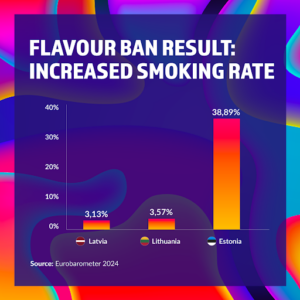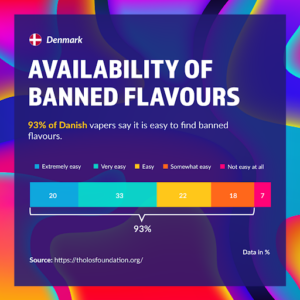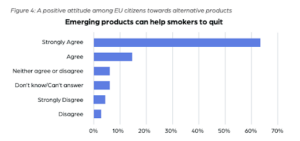The latest Eurobarometer 2024* reveals a startling failure in the EU’s approach to achieving its smoke-free target of a 5% smoking rate by 2040. At the current trend, the smoking rate will only fall below 5% by the year 2100, a full 60 years past the goal. This significant delay underscores the need for an urgent reassessment of current policies and approaches. The EU smoking rate dropped since 2021 to today only from 25% to 24%.
Flavour Bans: A Misguided Policy
Last week, many EU Health Ministers supported a flavour ban on safer nicotine products such as vaping and nicotine pouches. This decision undermines public health and disregards the voices of over 62,000 citizens who signed a petition against it. Denmark, Slovenia, Estonia, Latvia, and Lithuania, which have already implemented flavour bans, have seen catastrophic consequences and nevertheless were pushing the moste for a EU wide flavour ban. For example smoking rate since 2021:
- Latvia: Smoking rate increasedby 3.13%.
- Lithuania: Smoking rate increased by 3.57%.
- Estonia: Smoking rate increased by 38.89%!
Estonia implemented its flavour ban in 2019, followed by Lithuania in 2022, and is already experiencing the most severe consequences. These examples suggest that other EU countries could see similar negative trends. Notably, Estonia (9%) and Lithuania (8%) currently have the highest vaping rates in Europe, indicating a robust black market for flavoured products.

Black Market and Consumer Behavior: According to a Tholos Foundation survey, 93% of vapers in Denmark find it easy to access banned flavours, resulting in a thriving black market. Furthermore, 80% of vapers use these products for health-related reasons. If a flavour ban is enforced, many vapers may revert to smoking. This can definitley be called a win for public health. In Quebec, six months after implementing a flavour ban, 36% of initial vapers returned to smoking.

Public Opinion on Flavour Bans: Europe is divided on this issue: 51% of Europeans support flavour bans, while 49% oppose them according to the Eurobarometer. But those how are impacted by it most – nicotine consumers – see it differently. The EU Commission’s public consultation on future tobacco and nicotine regulation revealed that a majority supports harm-reduction products, including flavours. Only 5% believe that banning flavours in tobacco and related products significantly reduces health risks.
Usage and Preferences
- Heated Tobacco Products: Used by 2% of Europeans.
- Vaping: 3% of Europeans vape.
- Nicotine Pouches: Tried by 4% of Europeans.
- Smoking: 24% of EU czitizens are still smoking cigarettes.
- Vaping Preferences: 77% use open systems, 40% use pod systems, and 41% use disposable vapes.
- Flavours Used: 38% use tobacco flavour, 31% use menthol or mint, and 68% use fruit or candy flavours.
- Long-term Smoking: 63% of smokers have smoked for more than 20 years, but those smoking for ten years or less are more likely to have tried vaping or heated tobacco.
It’s clear that the biggest health challenge in the EU is reducing the smoking rate, which causes 700,000 deaths each year. Despite this, most discussions about future regulations are focused on limiting access to and affordability of less harmful nicotine alternatives. If EU decision-makers truly want to improve public health, they must end the moral panic about products that help smokers quit and pose only a fraction of the risk of smoking. Prioritizing harm reduction and supporting access to safer alternatives is crucial in the fight against smoking-related diseases.
Reasons for Vaping
- Stop or Reduce Smoking: 36%
- Health: 28% believe vaping is less harmful than smoking.
- Cost: 20% use vaping because it’s cheaper than smoking.
- Perceived Coolness or Attractiveness: 12%
- 92% of Europeans do not find these products appealing.
The perpetuated myth that vapers are somehow tricked by marketing into vaping or consuming similar products must stop, especially in light of the EU Commission’s own survey results. 92% of Europeans do not find these products appealing. Most people switch to vaping for health reasons or to save costs. Limiting flavours or products and increasing prices through taxes removes these incentives. The current proposals would unnecessarily perpetuate smoking-induced illnesses, undermining the very goal of reducing smoking rates and improving public health.
Sweden’s Success
- Snus Usage: 26% of people use snus.
- Nicotine Pouches: 20% have tried them.
- Result: Sweden’s smoking rate is three times lower than the EU average.
Sweden’s approach to nicotine consumption provides a compelling case for harm reduction. With 26% of people using snus and 20% having tried nicotine pouches, Sweden boasts the lowest smoking rate in the EU. Notably, Sweden is the only country on track to achieve the EU’s smoke-free goal of reducing the smoking rate to 5%. Over the last decade, smoking rates in Sweden have declined by 55%, leading to significant public health benefits. Smoking-related deaths in Sweden are 22% lower than the EU average, and cancer incidence is 41% lower, with total cancer deaths being 38% lower. These statistics highlight that it is not just the presence of nicotine, but how it is consumed, that matters for public health. Sweden’s success story underscores the importance of supporting safer nicotine alternatives to reduce smoking rates and improve health outcomes across Europe.
Smoking Cessation
- Effectiveness: Vaping was tried 2.5 times more often for smoking cessation compared to traditional nicotine replacement therapy (NRT).
- User Demographics: Only 3% of nicotine users started with vaping. The fast majority started with traditional cigarettes.
- Public Perception: Only 12% believe vaping can help smokers quit. However, 44% of vapers report that vaping helped them quit or reduce smoking.
Despite widespread misconceptions, vaping and other alternative nicotine products play a crucial role in smoking cessation. While only 3% of nicotine users started with vaping—most beginning with traditional cigarettes—these alternatives are vital for those looking to quit. Unfortunately, only 12% believe that vaping can help smokers quit. However, the reality is that 44% of vapers report that vaping helped them quit or reduce smoking.
Contrastingly, the EU Commission’s public consultation reveals a more optimistic view among European citizens. When asked about the potential of alternative products to help smokers quit, a significant majority agreed, with 77% agreeing. Only a small minority of 9% disagreed or strongly disagreed with this statement. These contrasting perspectives highlight the need for better education and awareness about the benefits of harm reduction products in combating smoking-related illnesses.

These findings highlight the urgent need for the EU to reassess its approach to vaping and harm reduction. Policies should focus on supporting smokers in switching to less harmful alternatives rather than imposing restrictive bans that drive them back to smoking or into black markets. Embracing harm reduction strategies, as seen in Sweden and the UK, could significantly accelerate progress towards the EU’s smoke-free goal.
*Survey Participation The Eurobarometer survey garnered 26,358 responses from various social and demographic groups, providing a comprehensive overview of public opinion and behaviour across the EU.




